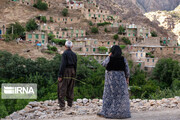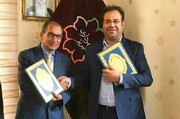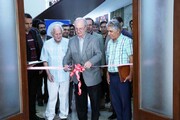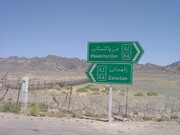Mostofi Historical House is located in the city of Boshrouyeh and belongs to the early Qajar Dynasty. The main ornamental element of this building is the symbol of all the desert towns, the tall wind tower, which is six meters high and decorated with stucco.
A wind-tower (wind catcher) is a traditional Iranian architectural element to create natural ventilation in buildings. Wind-catchers come in various designs: uni-directional, bi-directional, and multi-directional. The devices were used in ancient Iranian architecture. Wind-catchers remain present in Iran and can also be found in traditional Persian-influenced architecture throughout West Asia, including in the Arab states of the Persian Gulf, Pakistan, and Afghanistan.
Central Iran shows a large diurnal temperature variation with an arid climate. Most buildings are constructed from thick ceramic with high insulation values. Towns centered on desert oases tend to be packed very closely together with high walls and ceilings, maximizing shade at ground level. The heat of direct sunlight is minimized with small windows that face away from the sun.
The windcatcher's effectiveness had led to its routine use as a refrigerating device in Persian architecture. Many traditional water reservoirs (ab anbars) are built with windcatchers that are capable of storing water at near freezing temperatures during summer months. The evaporative cooling effect is strongest in the driest climates, such as on the Iranian plateau, leading to the ubiquitous use of windcatchers in drier areas such as Yazd, Kerman, Kashan, Sirjan, Nain, and Bam.
A small wind-catcher is called a shish-khan in traditional Persian architecture. Shish-khans can still be seen on top of ab-anbars (water reservoir) in Qazvin and other northern cities in Iran. These seem to function more as ventilators than as the temperature regulators seen in the central deserts of Iran.
The dome is another prominent element on its roof, with a variety of formal decorations and carvings, and wooden doors with colored glass and knotted with semicircular Roman arches, geometric designs, formalities and trappings, styling and carvings. The main porch and its heaters are other important decorative elements of the building.

The plaster grid of the basement dome is the highlight of this home, and in the pyramid of the dome, there are cups that, on the basis of the available evidence, have at least colored glass in four colors of red, orange, green and purple. Its geometric motifs are made up of fragments of a circle.
The outline of this mansion is rectangular and its entrance is in the middle of the southwest side. The layout of the rectangular space is carpeted with square bricks. A large porch on the west side of the mansion, with three massive windshields, includes a large rectangular windshield in the middle and two octagonal windshields on either side.
It is located in the eastern corner of the basin. The pond has an octagonal space with a small circular pond built in the center, The basement of the mansion has a fridge and has a rectangular space with a slight arch and sleeping bricks.
6125**1416
Follow us on Twitter @IrnaEnglish













Your Comment